Network Security and Surveillance Technologies
VerifiedAdded on 2020/04/21
|18
|3504
|91
AI Summary
This document presents a compilation of research papers focusing on various aspects of network security and surveillance. The papers delve into topics such as encryption methods, minimum spanning tree algorithms for energy efficiency in wireless networks, network video surveillance systems, and the performance analysis of hierarchical transform coding for video codecs. Additionally, the collection examines IPv6 protocol implementation, DHCP snooping for rogue access point detection, trust-based routing mechanisms, and multicast routing over dual-stack virtual local area networks.
Contribute Materials
Your contribution can guide someone’s learning journey. Share your
documents today.
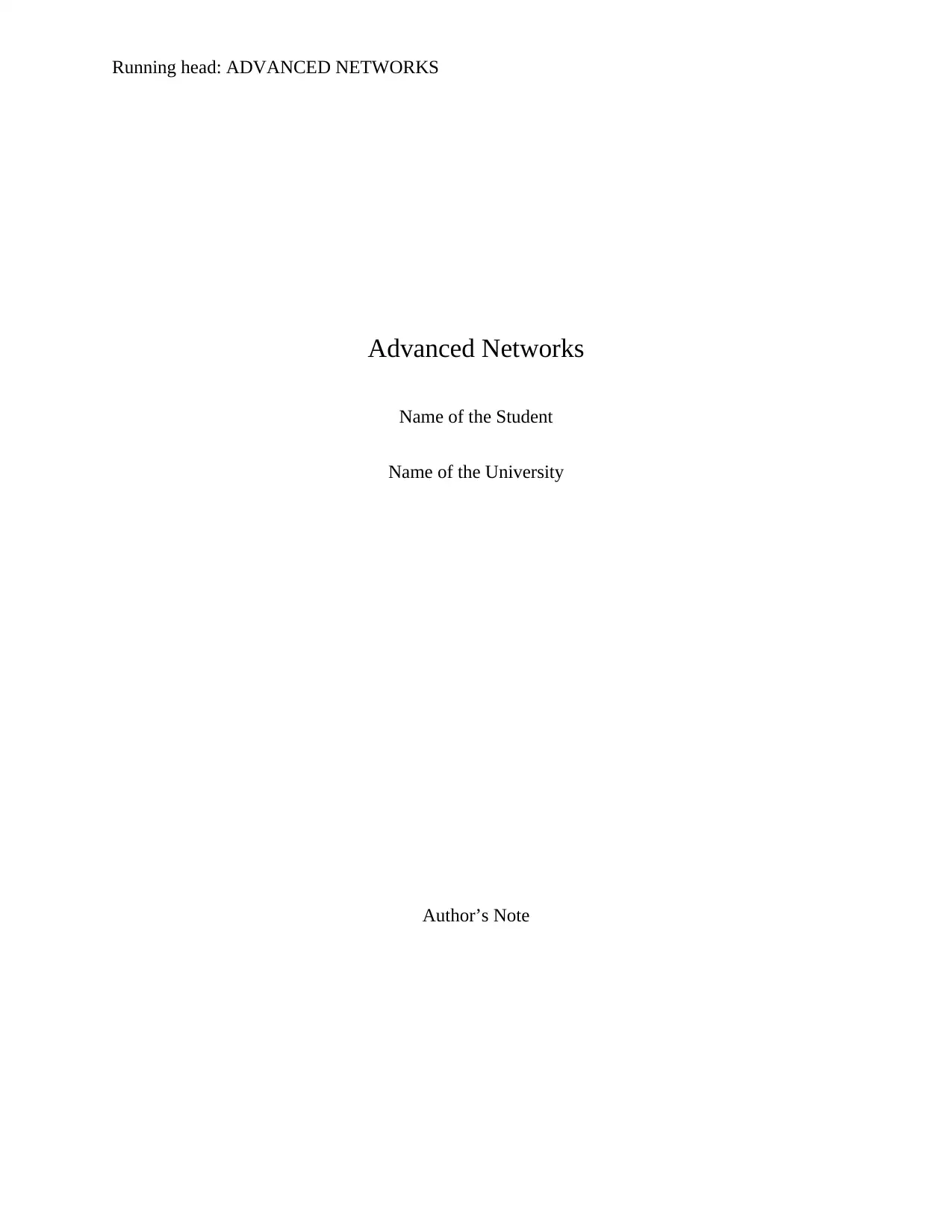
Running head: ADVANCED NETWORKS
Advanced Networks
Name of the Student
Name of the University
Author’s Note
Advanced Networks
Name of the Student
Name of the University
Author’s Note
Secure Best Marks with AI Grader
Need help grading? Try our AI Grader for instant feedback on your assignments.

1
ADVANCED NETWORKS
Table of Contents
PART 1 – Design.................................................................................................................3
Logical Design Diagram..................................................................................................3
IP Decision.......................................................................................................................3
IPv4 Subnetting...............................................................................................................5
Transition mechanism from Ipv4 to Ipv6 Subnet Designs..............................................5
Part 2 – Design Report.........................................................................................................7
1. Introduction..................................................................................................................7
2. Description of the model.............................................................................................7
3. Design..........................................................................................................................8
4. Business Requirement.................................................................................................9
5. Protocols....................................................................................................................10
5.1. Video compression Codecs.................................................................................10
5.2. Pan-Tilt-Zoom (PTZ)..........................................................................................11
5.3. UDP/RTP............................................................................................................11
5.4. HSRP..................................................................................................................12
5.5. Gateway Load balancing....................................................................................12
5.6. Spanning Tree.....................................................................................................12
5.7. PortFast Bridge protocol data Unit.....................................................................13
6. Security......................................................................................................................13
ADVANCED NETWORKS
Table of Contents
PART 1 – Design.................................................................................................................3
Logical Design Diagram..................................................................................................3
IP Decision.......................................................................................................................3
IPv4 Subnetting...............................................................................................................5
Transition mechanism from Ipv4 to Ipv6 Subnet Designs..............................................5
Part 2 – Design Report.........................................................................................................7
1. Introduction..................................................................................................................7
2. Description of the model.............................................................................................7
3. Design..........................................................................................................................8
4. Business Requirement.................................................................................................9
5. Protocols....................................................................................................................10
5.1. Video compression Codecs.................................................................................10
5.2. Pan-Tilt-Zoom (PTZ)..........................................................................................11
5.3. UDP/RTP............................................................................................................11
5.4. HSRP..................................................................................................................12
5.5. Gateway Load balancing....................................................................................12
5.6. Spanning Tree.....................................................................................................12
5.7. PortFast Bridge protocol data Unit.....................................................................13
6. Security......................................................................................................................13

2
ADVANCED NETWORKS
Conclusion.....................................................................................................................14
Bibliography......................................................................................................................15
ADVANCED NETWORKS
Conclusion.....................................................................................................................14
Bibliography......................................................................................................................15
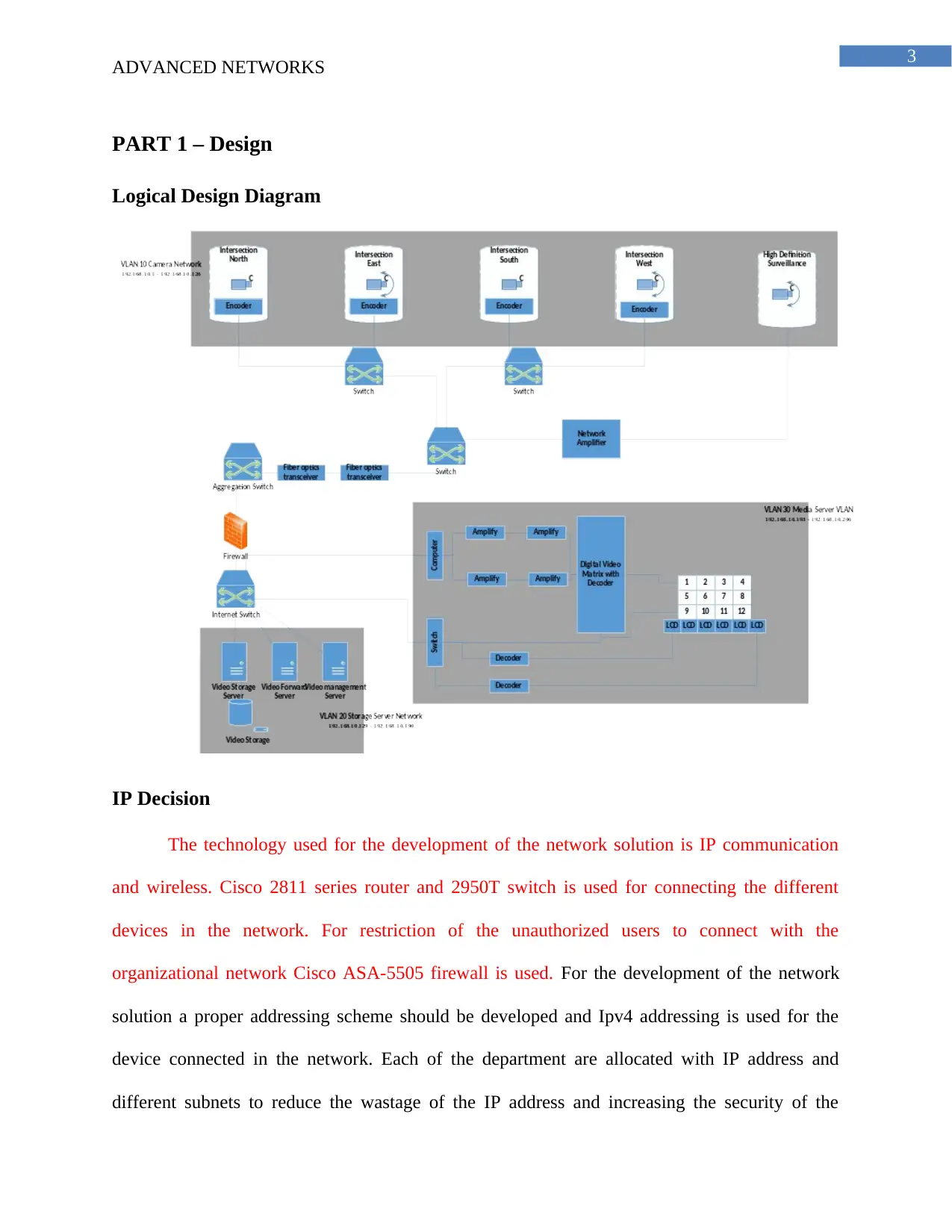
3
ADVANCED NETWORKS
PART 1 – Design
Logical Design Diagram
IP Decision
The technology used for the development of the network solution is IP communication
and wireless. Cisco 2811 series router and 2950T switch is used for connecting the different
devices in the network. For restriction of the unauthorized users to connect with the
organizational network Cisco ASA-5505 firewall is used. For the development of the network
solution a proper addressing scheme should be developed and Ipv4 addressing is used for the
device connected in the network. Each of the department are allocated with IP address and
different subnets to reduce the wastage of the IP address and increasing the security of the
ADVANCED NETWORKS
PART 1 – Design
Logical Design Diagram
IP Decision
The technology used for the development of the network solution is IP communication
and wireless. Cisco 2811 series router and 2950T switch is used for connecting the different
devices in the network. For restriction of the unauthorized users to connect with the
organizational network Cisco ASA-5505 firewall is used. For the development of the network
solution a proper addressing scheme should be developed and Ipv4 addressing is used for the
device connected in the network. Each of the department are allocated with IP address and
different subnets to reduce the wastage of the IP address and increasing the security of the
Secure Best Marks with AI Grader
Need help grading? Try our AI Grader for instant feedback on your assignments.
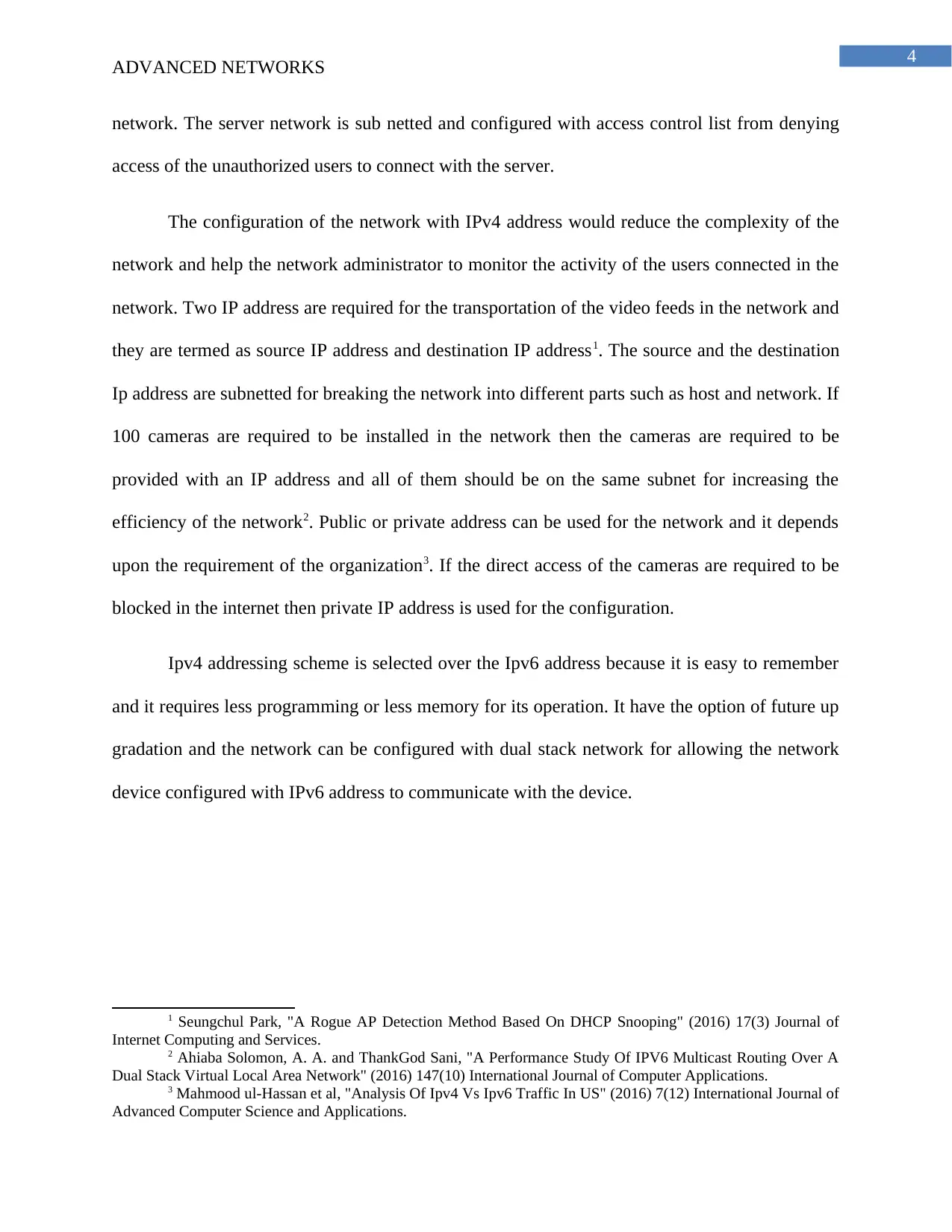
4
ADVANCED NETWORKS
network. The server network is sub netted and configured with access control list from denying
access of the unauthorized users to connect with the server.
The configuration of the network with IPv4 address would reduce the complexity of the
network and help the network administrator to monitor the activity of the users connected in the
network. Two IP address are required for the transportation of the video feeds in the network and
they are termed as source IP address and destination IP address1. The source and the destination
Ip address are subnetted for breaking the network into different parts such as host and network. If
100 cameras are required to be installed in the network then the cameras are required to be
provided with an IP address and all of them should be on the same subnet for increasing the
efficiency of the network2. Public or private address can be used for the network and it depends
upon the requirement of the organization3. If the direct access of the cameras are required to be
blocked in the internet then private IP address is used for the configuration.
Ipv4 addressing scheme is selected over the Ipv6 address because it is easy to remember
and it requires less programming or less memory for its operation. It have the option of future up
gradation and the network can be configured with dual stack network for allowing the network
device configured with IPv6 address to communicate with the device.
1 Seungchul Park, "A Rogue AP Detection Method Based On DHCP Snooping" (2016) 17(3) Journal of
Internet Computing and Services.
2 Ahiaba Solomon, A. A. and ThankGod Sani, "A Performance Study Of IPV6 Multicast Routing Over A
Dual Stack Virtual Local Area Network" (2016) 147(10) International Journal of Computer Applications.
3 Mahmood ul-Hassan et al, "Analysis Of Ipv4 Vs Ipv6 Traffic In US" (2016) 7(12) International Journal of
Advanced Computer Science and Applications.
ADVANCED NETWORKS
network. The server network is sub netted and configured with access control list from denying
access of the unauthorized users to connect with the server.
The configuration of the network with IPv4 address would reduce the complexity of the
network and help the network administrator to monitor the activity of the users connected in the
network. Two IP address are required for the transportation of the video feeds in the network and
they are termed as source IP address and destination IP address1. The source and the destination
Ip address are subnetted for breaking the network into different parts such as host and network. If
100 cameras are required to be installed in the network then the cameras are required to be
provided with an IP address and all of them should be on the same subnet for increasing the
efficiency of the network2. Public or private address can be used for the network and it depends
upon the requirement of the organization3. If the direct access of the cameras are required to be
blocked in the internet then private IP address is used for the configuration.
Ipv4 addressing scheme is selected over the Ipv6 address because it is easy to remember
and it requires less programming or less memory for its operation. It have the option of future up
gradation and the network can be configured with dual stack network for allowing the network
device configured with IPv6 address to communicate with the device.
1 Seungchul Park, "A Rogue AP Detection Method Based On DHCP Snooping" (2016) 17(3) Journal of
Internet Computing and Services.
2 Ahiaba Solomon, A. A. and ThankGod Sani, "A Performance Study Of IPV6 Multicast Routing Over A
Dual Stack Virtual Local Area Network" (2016) 147(10) International Journal of Computer Applications.
3 Mahmood ul-Hassan et al, "Analysis Of Ipv4 Vs Ipv6 Traffic In US" (2016) 7(12) International Journal of
Advanced Computer Science and Applications.
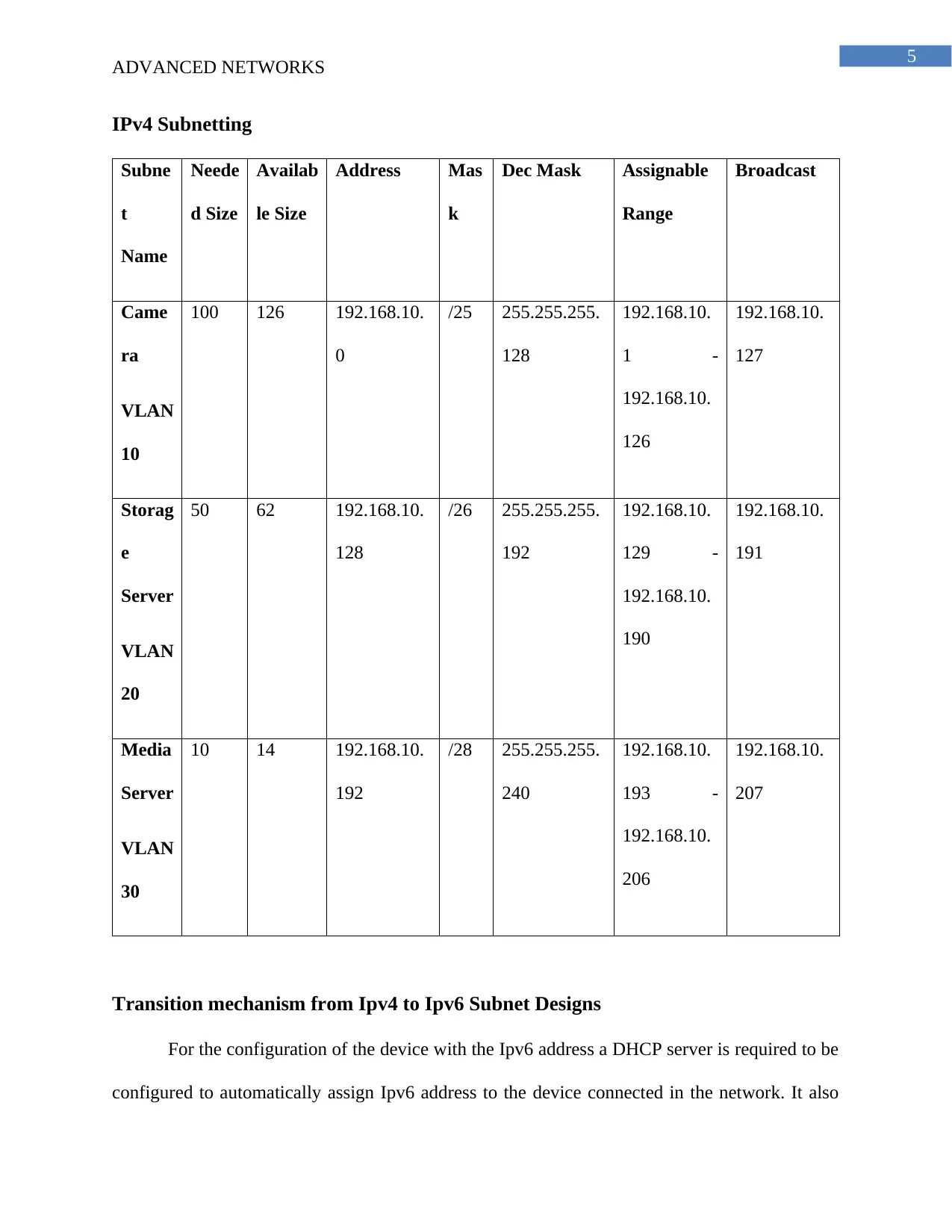
5
ADVANCED NETWORKS
IPv4 Subnetting
Subne
t
Name
Neede
d Size
Availab
le Size
Address Mas
k
Dec Mask Assignable
Range
Broadcast
Came
ra
VLAN
10
100 126 192.168.10.
0
/25 255.255.255.
128
192.168.10.
1 -
192.168.10.
126
192.168.10.
127
Storag
e
Server
VLAN
20
50 62 192.168.10.
128
/26 255.255.255.
192
192.168.10.
129 -
192.168.10.
190
192.168.10.
191
Media
Server
VLAN
30
10 14 192.168.10.
192
/28 255.255.255.
240
192.168.10.
193 -
192.168.10.
206
192.168.10.
207
Transition mechanism from Ipv4 to Ipv6 Subnet Designs
For the configuration of the device with the Ipv6 address a DHCP server is required to be
configured to automatically assign Ipv6 address to the device connected in the network. It also
ADVANCED NETWORKS
IPv4 Subnetting
Subne
t
Name
Neede
d Size
Availab
le Size
Address Mas
k
Dec Mask Assignable
Range
Broadcast
Came
ra
VLAN
10
100 126 192.168.10.
0
/25 255.255.255.
128
192.168.10.
1 -
192.168.10.
126
192.168.10.
127
Storag
e
Server
VLAN
20
50 62 192.168.10.
128
/26 255.255.255.
192
192.168.10.
129 -
192.168.10.
190
192.168.10.
191
Media
Server
VLAN
30
10 14 192.168.10.
192
/28 255.255.255.
240
192.168.10.
193 -
192.168.10.
206
192.168.10.
207
Transition mechanism from Ipv4 to Ipv6 Subnet Designs
For the configuration of the device with the Ipv6 address a DHCP server is required to be
configured to automatically assign Ipv6 address to the device connected in the network. It also
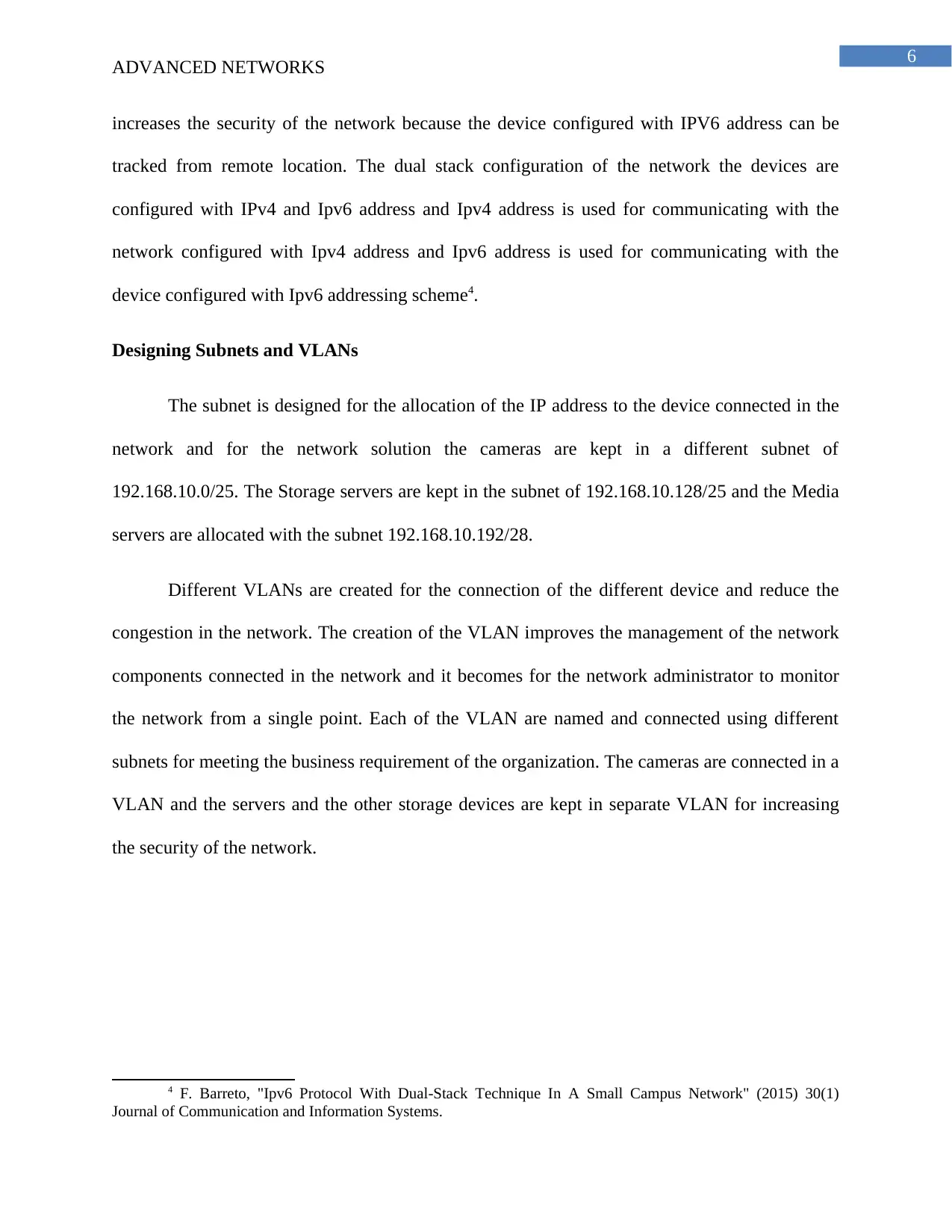
6
ADVANCED NETWORKS
increases the security of the network because the device configured with IPV6 address can be
tracked from remote location. The dual stack configuration of the network the devices are
configured with IPv4 and Ipv6 address and Ipv4 address is used for communicating with the
network configured with Ipv4 address and Ipv6 address is used for communicating with the
device configured with Ipv6 addressing scheme4.
Designing Subnets and VLANs
The subnet is designed for the allocation of the IP address to the device connected in the
network and for the network solution the cameras are kept in a different subnet of
192.168.10.0/25. The Storage servers are kept in the subnet of 192.168.10.128/25 and the Media
servers are allocated with the subnet 192.168.10.192/28.
Different VLANs are created for the connection of the different device and reduce the
congestion in the network. The creation of the VLAN improves the management of the network
components connected in the network and it becomes for the network administrator to monitor
the network from a single point. Each of the VLAN are named and connected using different
subnets for meeting the business requirement of the organization. The cameras are connected in a
VLAN and the servers and the other storage devices are kept in separate VLAN for increasing
the security of the network.
4 F. Barreto, "Ipv6 Protocol With Dual-Stack Technique In A Small Campus Network" (2015) 30(1)
Journal of Communication and Information Systems.
ADVANCED NETWORKS
increases the security of the network because the device configured with IPV6 address can be
tracked from remote location. The dual stack configuration of the network the devices are
configured with IPv4 and Ipv6 address and Ipv4 address is used for communicating with the
network configured with Ipv4 address and Ipv6 address is used for communicating with the
device configured with Ipv6 addressing scheme4.
Designing Subnets and VLANs
The subnet is designed for the allocation of the IP address to the device connected in the
network and for the network solution the cameras are kept in a different subnet of
192.168.10.0/25. The Storage servers are kept in the subnet of 192.168.10.128/25 and the Media
servers are allocated with the subnet 192.168.10.192/28.
Different VLANs are created for the connection of the different device and reduce the
congestion in the network. The creation of the VLAN improves the management of the network
components connected in the network and it becomes for the network administrator to monitor
the network from a single point. Each of the VLAN are named and connected using different
subnets for meeting the business requirement of the organization. The cameras are connected in a
VLAN and the servers and the other storage devices are kept in separate VLAN for increasing
the security of the network.
4 F. Barreto, "Ipv6 Protocol With Dual-Stack Technique In A Small Campus Network" (2015) 30(1)
Journal of Communication and Information Systems.
Paraphrase This Document
Need a fresh take? Get an instant paraphrase of this document with our AI Paraphraser
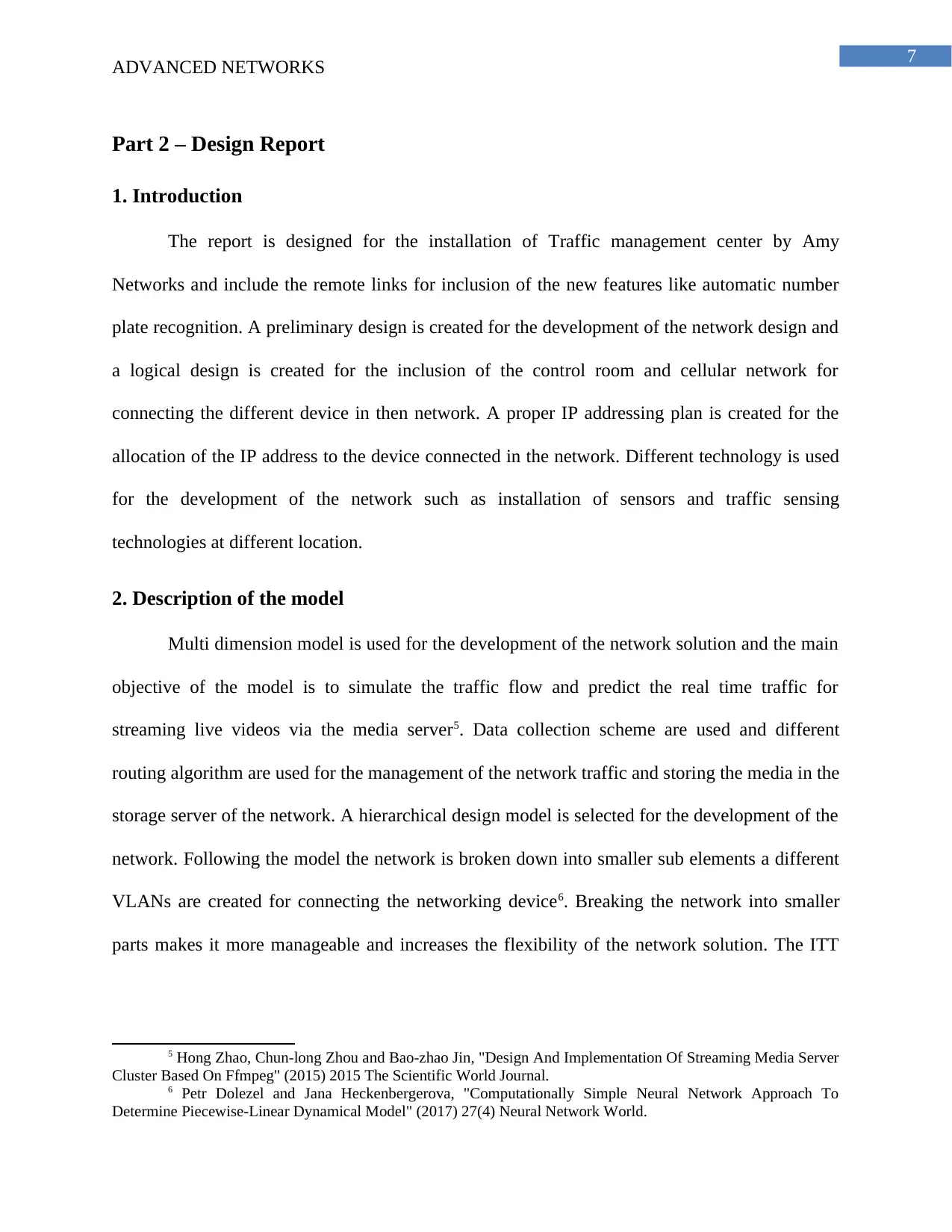
7
ADVANCED NETWORKS
Part 2 – Design Report
1. Introduction
The report is designed for the installation of Traffic management center by Amy
Networks and include the remote links for inclusion of the new features like automatic number
plate recognition. A preliminary design is created for the development of the network design and
a logical design is created for the inclusion of the control room and cellular network for
connecting the different device in then network. A proper IP addressing plan is created for the
allocation of the IP address to the device connected in the network. Different technology is used
for the development of the network such as installation of sensors and traffic sensing
technologies at different location.
2. Description of the model
Multi dimension model is used for the development of the network solution and the main
objective of the model is to simulate the traffic flow and predict the real time traffic for
streaming live videos via the media server5. Data collection scheme are used and different
routing algorithm are used for the management of the network traffic and storing the media in the
storage server of the network. A hierarchical design model is selected for the development of the
network. Following the model the network is broken down into smaller sub elements a different
VLANs are created for connecting the networking device6. Breaking the network into smaller
parts makes it more manageable and increases the flexibility of the network solution. The ITT
5 Hong Zhao, Chun-long Zhou and Bao-zhao Jin, "Design And Implementation Of Streaming Media Server
Cluster Based On Ffmpeg" (2015) 2015 The Scientific World Journal.
6 Petr Dolezel and Jana Heckenbergerova, "Computationally Simple Neural Network Approach To
Determine Piecewise-Linear Dynamical Model" (2017) 27(4) Neural Network World.
ADVANCED NETWORKS
Part 2 – Design Report
1. Introduction
The report is designed for the installation of Traffic management center by Amy
Networks and include the remote links for inclusion of the new features like automatic number
plate recognition. A preliminary design is created for the development of the network design and
a logical design is created for the inclusion of the control room and cellular network for
connecting the different device in then network. A proper IP addressing plan is created for the
allocation of the IP address to the device connected in the network. Different technology is used
for the development of the network such as installation of sensors and traffic sensing
technologies at different location.
2. Description of the model
Multi dimension model is used for the development of the network solution and the main
objective of the model is to simulate the traffic flow and predict the real time traffic for
streaming live videos via the media server5. Data collection scheme are used and different
routing algorithm are used for the management of the network traffic and storing the media in the
storage server of the network. A hierarchical design model is selected for the development of the
network. Following the model the network is broken down into smaller sub elements a different
VLANs are created for connecting the networking device6. Breaking the network into smaller
parts makes it more manageable and increases the flexibility of the network solution. The ITT
5 Hong Zhao, Chun-long Zhou and Bao-zhao Jin, "Design And Implementation Of Streaming Media Server
Cluster Based On Ffmpeg" (2015) 2015 The Scientific World Journal.
6 Petr Dolezel and Jana Heckenbergerova, "Computationally Simple Neural Network Approach To
Determine Piecewise-Linear Dynamical Model" (2017) 27(4) Neural Network World.
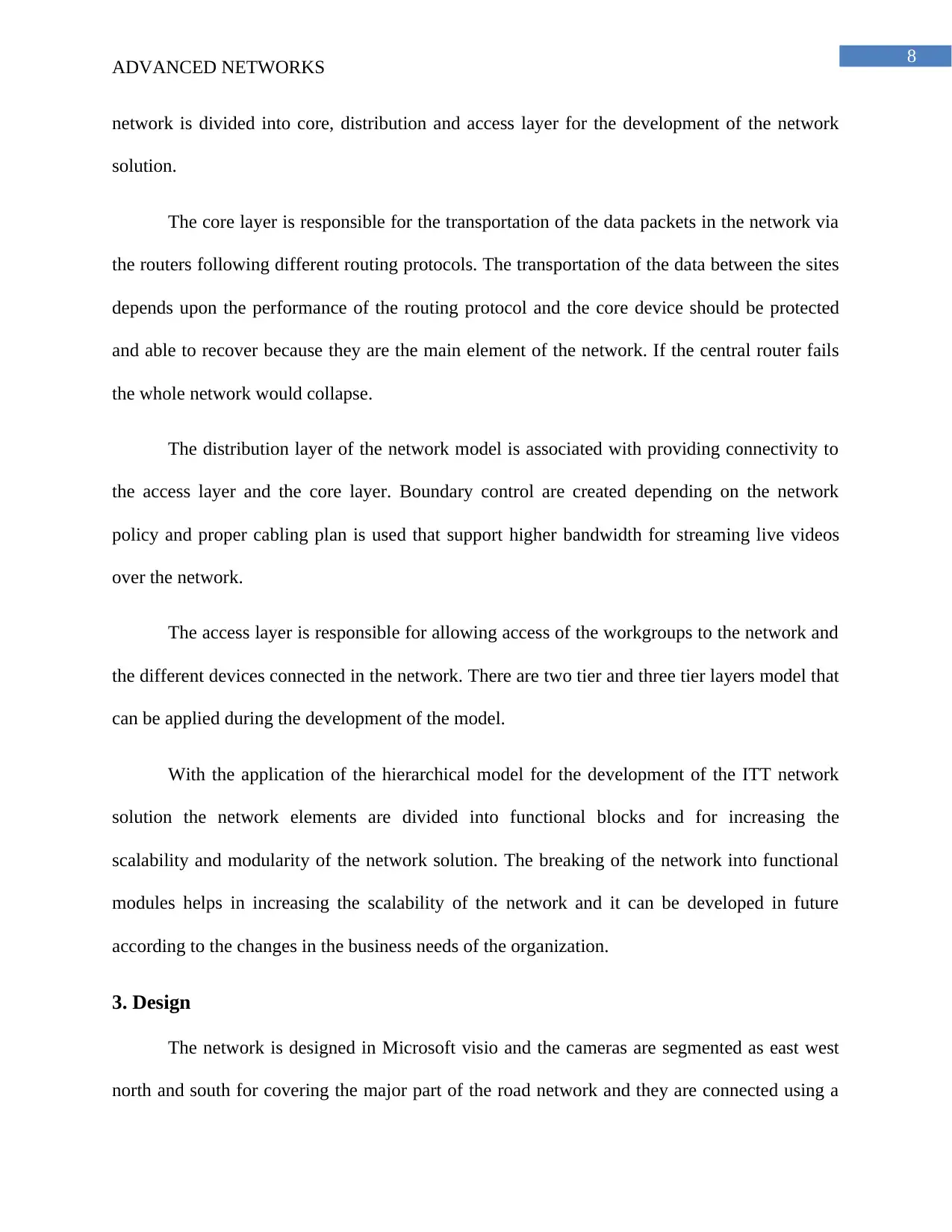
8
ADVANCED NETWORKS
network is divided into core, distribution and access layer for the development of the network
solution.
The core layer is responsible for the transportation of the data packets in the network via
the routers following different routing protocols. The transportation of the data between the sites
depends upon the performance of the routing protocol and the core device should be protected
and able to recover because they are the main element of the network. If the central router fails
the whole network would collapse.
The distribution layer of the network model is associated with providing connectivity to
the access layer and the core layer. Boundary control are created depending on the network
policy and proper cabling plan is used that support higher bandwidth for streaming live videos
over the network.
The access layer is responsible for allowing access of the workgroups to the network and
the different devices connected in the network. There are two tier and three tier layers model that
can be applied during the development of the model.
With the application of the hierarchical model for the development of the ITT network
solution the network elements are divided into functional blocks and for increasing the
scalability and modularity of the network solution. The breaking of the network into functional
modules helps in increasing the scalability of the network and it can be developed in future
according to the changes in the business needs of the organization.
3. Design
The network is designed in Microsoft visio and the cameras are segmented as east west
north and south for covering the major part of the road network and they are connected using a
ADVANCED NETWORKS
network is divided into core, distribution and access layer for the development of the network
solution.
The core layer is responsible for the transportation of the data packets in the network via
the routers following different routing protocols. The transportation of the data between the sites
depends upon the performance of the routing protocol and the core device should be protected
and able to recover because they are the main element of the network. If the central router fails
the whole network would collapse.
The distribution layer of the network model is associated with providing connectivity to
the access layer and the core layer. Boundary control are created depending on the network
policy and proper cabling plan is used that support higher bandwidth for streaming live videos
over the network.
The access layer is responsible for allowing access of the workgroups to the network and
the different devices connected in the network. There are two tier and three tier layers model that
can be applied during the development of the model.
With the application of the hierarchical model for the development of the ITT network
solution the network elements are divided into functional blocks and for increasing the
scalability and modularity of the network solution. The breaking of the network into functional
modules helps in increasing the scalability of the network and it can be developed in future
according to the changes in the business needs of the organization.
3. Design
The network is designed in Microsoft visio and the cameras are segmented as east west
north and south for covering the major part of the road network and they are connected using a
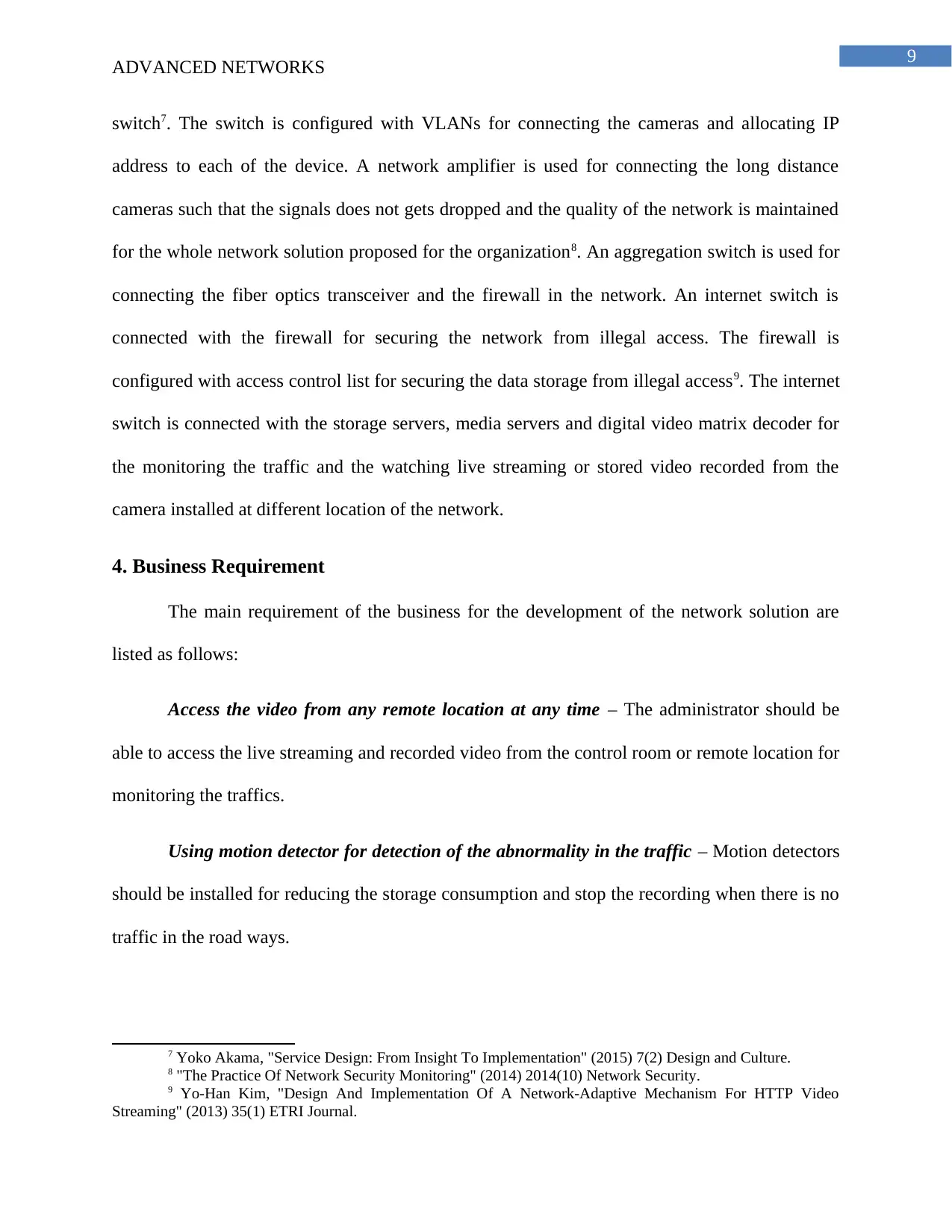
9
ADVANCED NETWORKS
switch7. The switch is configured with VLANs for connecting the cameras and allocating IP
address to each of the device. A network amplifier is used for connecting the long distance
cameras such that the signals does not gets dropped and the quality of the network is maintained
for the whole network solution proposed for the organization8. An aggregation switch is used for
connecting the fiber optics transceiver and the firewall in the network. An internet switch is
connected with the firewall for securing the network from illegal access. The firewall is
configured with access control list for securing the data storage from illegal access9. The internet
switch is connected with the storage servers, media servers and digital video matrix decoder for
the monitoring the traffic and the watching live streaming or stored video recorded from the
camera installed at different location of the network.
4. Business Requirement
The main requirement of the business for the development of the network solution are
listed as follows:
Access the video from any remote location at any time – The administrator should be
able to access the live streaming and recorded video from the control room or remote location for
monitoring the traffics.
Using motion detector for detection of the abnormality in the traffic – Motion detectors
should be installed for reducing the storage consumption and stop the recording when there is no
traffic in the road ways.
7 Yoko Akama, "Service Design: From Insight To Implementation" (2015) 7(2) Design and Culture.
8 "The Practice Of Network Security Monitoring" (2014) 2014(10) Network Security.
9 Yo-Han Kim, "Design And Implementation Of A Network-Adaptive Mechanism For HTTP Video
Streaming" (2013) 35(1) ETRI Journal.
ADVANCED NETWORKS
switch7. The switch is configured with VLANs for connecting the cameras and allocating IP
address to each of the device. A network amplifier is used for connecting the long distance
cameras such that the signals does not gets dropped and the quality of the network is maintained
for the whole network solution proposed for the organization8. An aggregation switch is used for
connecting the fiber optics transceiver and the firewall in the network. An internet switch is
connected with the firewall for securing the network from illegal access. The firewall is
configured with access control list for securing the data storage from illegal access9. The internet
switch is connected with the storage servers, media servers and digital video matrix decoder for
the monitoring the traffic and the watching live streaming or stored video recorded from the
camera installed at different location of the network.
4. Business Requirement
The main requirement of the business for the development of the network solution are
listed as follows:
Access the video from any remote location at any time – The administrator should be
able to access the live streaming and recorded video from the control room or remote location for
monitoring the traffics.
Using motion detector for detection of the abnormality in the traffic – Motion detectors
should be installed for reducing the storage consumption and stop the recording when there is no
traffic in the road ways.
7 Yoko Akama, "Service Design: From Insight To Implementation" (2015) 7(2) Design and Culture.
8 "The Practice Of Network Security Monitoring" (2014) 2014(10) Network Security.
9 Yo-Han Kim, "Design And Implementation Of A Network-Adaptive Mechanism For HTTP Video
Streaming" (2013) 35(1) ETRI Journal.
Secure Best Marks with AI Grader
Need help grading? Try our AI Grader for instant feedback on your assignments.
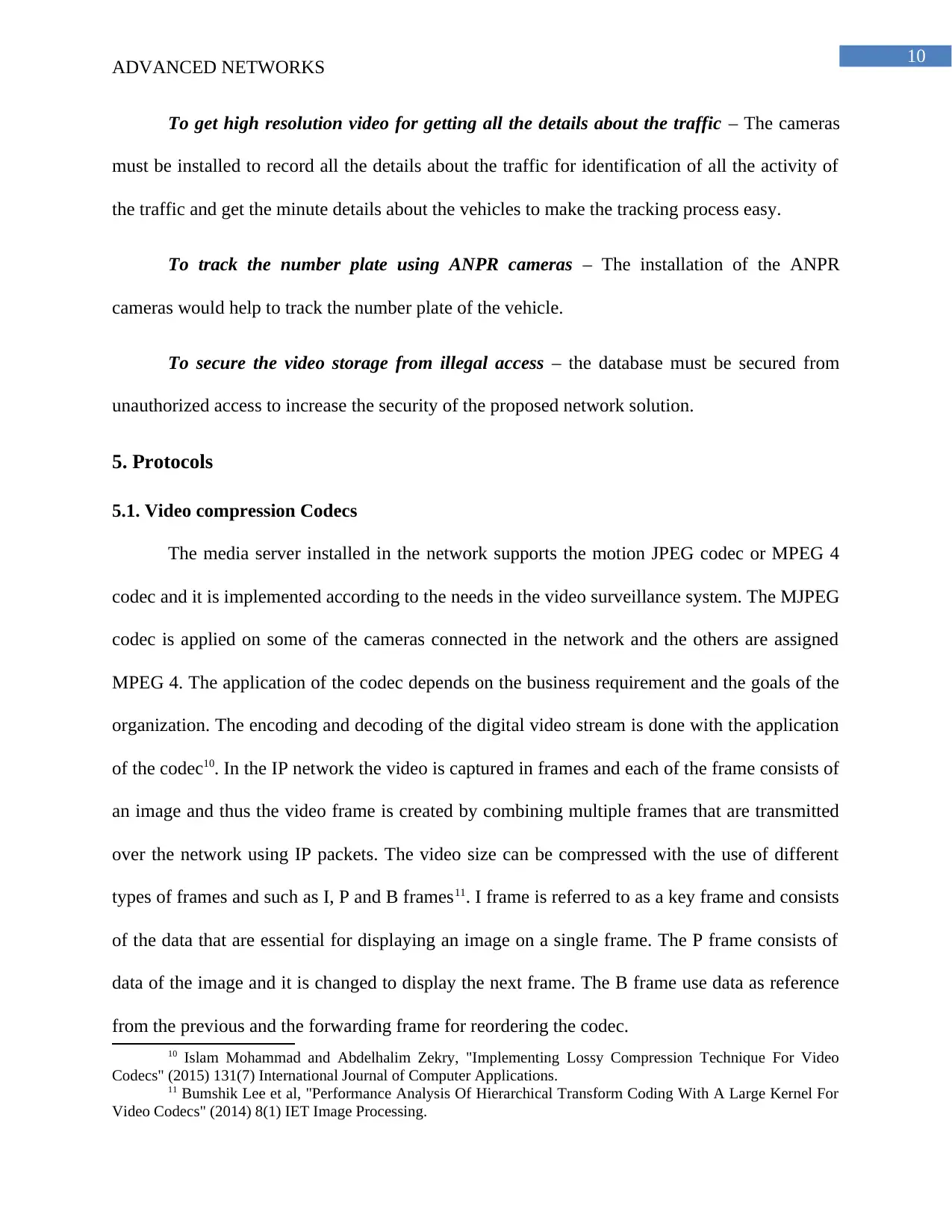
10
ADVANCED NETWORKS
To get high resolution video for getting all the details about the traffic – The cameras
must be installed to record all the details about the traffic for identification of all the activity of
the traffic and get the minute details about the vehicles to make the tracking process easy.
To track the number plate using ANPR cameras – The installation of the ANPR
cameras would help to track the number plate of the vehicle.
To secure the video storage from illegal access – the database must be secured from
unauthorized access to increase the security of the proposed network solution.
5. Protocols
5.1. Video compression Codecs
The media server installed in the network supports the motion JPEG codec or MPEG 4
codec and it is implemented according to the needs in the video surveillance system. The MJPEG
codec is applied on some of the cameras connected in the network and the others are assigned
MPEG 4. The application of the codec depends on the business requirement and the goals of the
organization. The encoding and decoding of the digital video stream is done with the application
of the codec10. In the IP network the video is captured in frames and each of the frame consists of
an image and thus the video frame is created by combining multiple frames that are transmitted
over the network using IP packets. The video size can be compressed with the use of different
types of frames and such as I, P and B frames11. I frame is referred to as a key frame and consists
of the data that are essential for displaying an image on a single frame. The P frame consists of
data of the image and it is changed to display the next frame. The B frame use data as reference
from the previous and the forwarding frame for reordering the codec.
10 Islam Mohammad and Abdelhalim Zekry, "Implementing Lossy Compression Technique For Video
Codecs" (2015) 131(7) International Journal of Computer Applications.
11 Bumshik Lee et al, "Performance Analysis Of Hierarchical Transform Coding With A Large Kernel For
Video Codecs" (2014) 8(1) IET Image Processing.
ADVANCED NETWORKS
To get high resolution video for getting all the details about the traffic – The cameras
must be installed to record all the details about the traffic for identification of all the activity of
the traffic and get the minute details about the vehicles to make the tracking process easy.
To track the number plate using ANPR cameras – The installation of the ANPR
cameras would help to track the number plate of the vehicle.
To secure the video storage from illegal access – the database must be secured from
unauthorized access to increase the security of the proposed network solution.
5. Protocols
5.1. Video compression Codecs
The media server installed in the network supports the motion JPEG codec or MPEG 4
codec and it is implemented according to the needs in the video surveillance system. The MJPEG
codec is applied on some of the cameras connected in the network and the others are assigned
MPEG 4. The application of the codec depends on the business requirement and the goals of the
organization. The encoding and decoding of the digital video stream is done with the application
of the codec10. In the IP network the video is captured in frames and each of the frame consists of
an image and thus the video frame is created by combining multiple frames that are transmitted
over the network using IP packets. The video size can be compressed with the use of different
types of frames and such as I, P and B frames11. I frame is referred to as a key frame and consists
of the data that are essential for displaying an image on a single frame. The P frame consists of
data of the image and it is changed to display the next frame. The B frame use data as reference
from the previous and the forwarding frame for reordering the codec.
10 Islam Mohammad and Abdelhalim Zekry, "Implementing Lossy Compression Technique For Video
Codecs" (2015) 131(7) International Journal of Computer Applications.
11 Bumshik Lee et al, "Performance Analysis Of Hierarchical Transform Coding With A Large Kernel For
Video Codecs" (2014) 8(1) IET Image Processing.
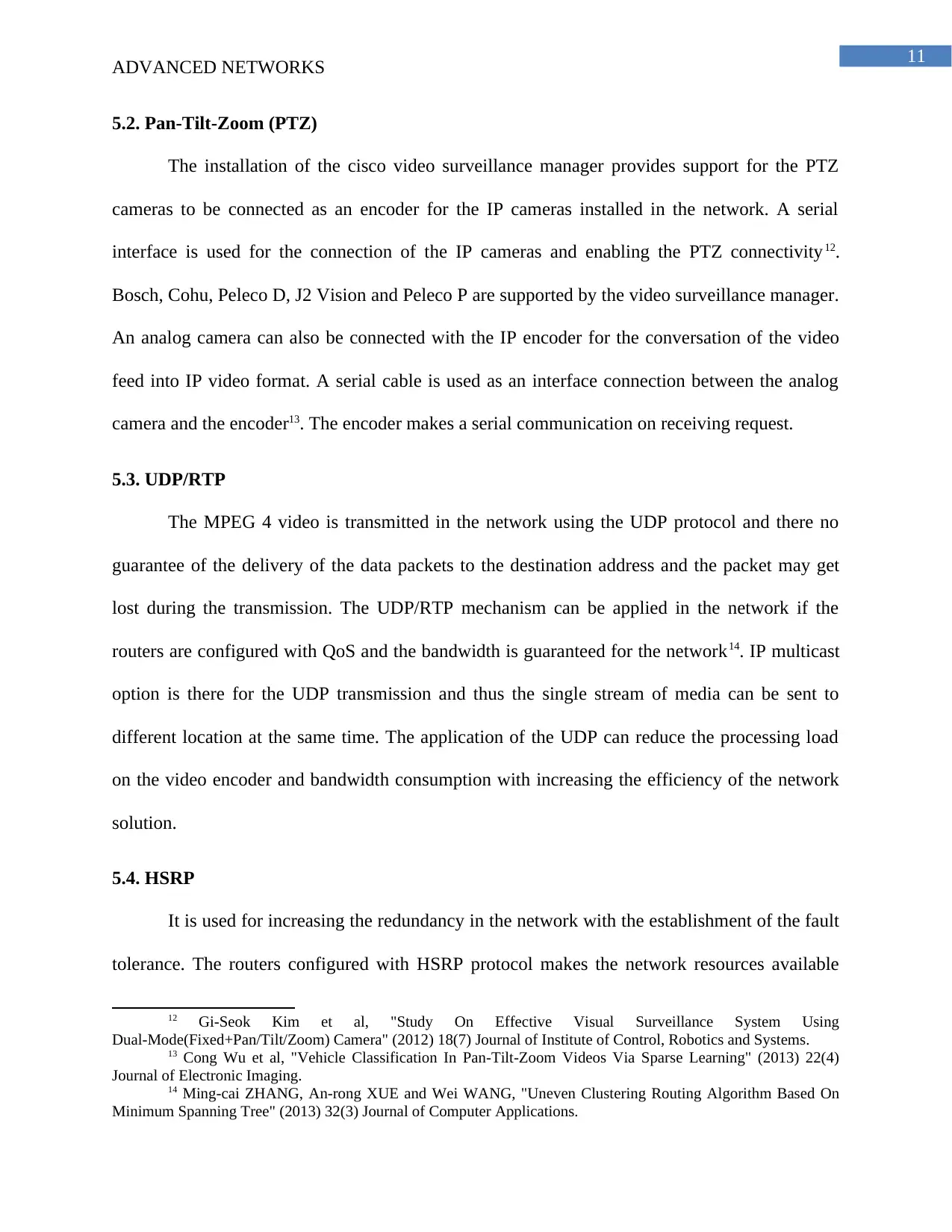
11
ADVANCED NETWORKS
5.2. Pan-Tilt-Zoom (PTZ)
The installation of the cisco video surveillance manager provides support for the PTZ
cameras to be connected as an encoder for the IP cameras installed in the network. A serial
interface is used for the connection of the IP cameras and enabling the PTZ connectivity12.
Bosch, Cohu, Peleco D, J2 Vision and Peleco P are supported by the video surveillance manager.
An analog camera can also be connected with the IP encoder for the conversation of the video
feed into IP video format. A serial cable is used as an interface connection between the analog
camera and the encoder13. The encoder makes a serial communication on receiving request.
5.3. UDP/RTP
The MPEG 4 video is transmitted in the network using the UDP protocol and there no
guarantee of the delivery of the data packets to the destination address and the packet may get
lost during the transmission. The UDP/RTP mechanism can be applied in the network if the
routers are configured with QoS and the bandwidth is guaranteed for the network14. IP multicast
option is there for the UDP transmission and thus the single stream of media can be sent to
different location at the same time. The application of the UDP can reduce the processing load
on the video encoder and bandwidth consumption with increasing the efficiency of the network
solution.
5.4. HSRP
It is used for increasing the redundancy in the network with the establishment of the fault
tolerance. The routers configured with HSRP protocol makes the network resources available
12 Gi-Seok Kim et al, "Study On Effective Visual Surveillance System Using
Dual-Mode(Fixed+Pan/Tilt/Zoom) Camera" (2012) 18(7) Journal of Institute of Control, Robotics and Systems.
13 Cong Wu et al, "Vehicle Classification In Pan-Tilt-Zoom Videos Via Sparse Learning" (2013) 22(4)
Journal of Electronic Imaging.
14 Ming-cai ZHANG, An-rong XUE and Wei WANG, "Uneven Clustering Routing Algorithm Based On
Minimum Spanning Tree" (2013) 32(3) Journal of Computer Applications.
ADVANCED NETWORKS
5.2. Pan-Tilt-Zoom (PTZ)
The installation of the cisco video surveillance manager provides support for the PTZ
cameras to be connected as an encoder for the IP cameras installed in the network. A serial
interface is used for the connection of the IP cameras and enabling the PTZ connectivity12.
Bosch, Cohu, Peleco D, J2 Vision and Peleco P are supported by the video surveillance manager.
An analog camera can also be connected with the IP encoder for the conversation of the video
feed into IP video format. A serial cable is used as an interface connection between the analog
camera and the encoder13. The encoder makes a serial communication on receiving request.
5.3. UDP/RTP
The MPEG 4 video is transmitted in the network using the UDP protocol and there no
guarantee of the delivery of the data packets to the destination address and the packet may get
lost during the transmission. The UDP/RTP mechanism can be applied in the network if the
routers are configured with QoS and the bandwidth is guaranteed for the network14. IP multicast
option is there for the UDP transmission and thus the single stream of media can be sent to
different location at the same time. The application of the UDP can reduce the processing load
on the video encoder and bandwidth consumption with increasing the efficiency of the network
solution.
5.4. HSRP
It is used for increasing the redundancy in the network with the establishment of the fault
tolerance. The routers configured with HSRP protocol makes the network resources available
12 Gi-Seok Kim et al, "Study On Effective Visual Surveillance System Using
Dual-Mode(Fixed+Pan/Tilt/Zoom) Camera" (2012) 18(7) Journal of Institute of Control, Robotics and Systems.
13 Cong Wu et al, "Vehicle Classification In Pan-Tilt-Zoom Videos Via Sparse Learning" (2013) 22(4)
Journal of Electronic Imaging.
14 Ming-cai ZHANG, An-rong XUE and Wei WANG, "Uneven Clustering Routing Algorithm Based On
Minimum Spanning Tree" (2013) 32(3) Journal of Computer Applications.
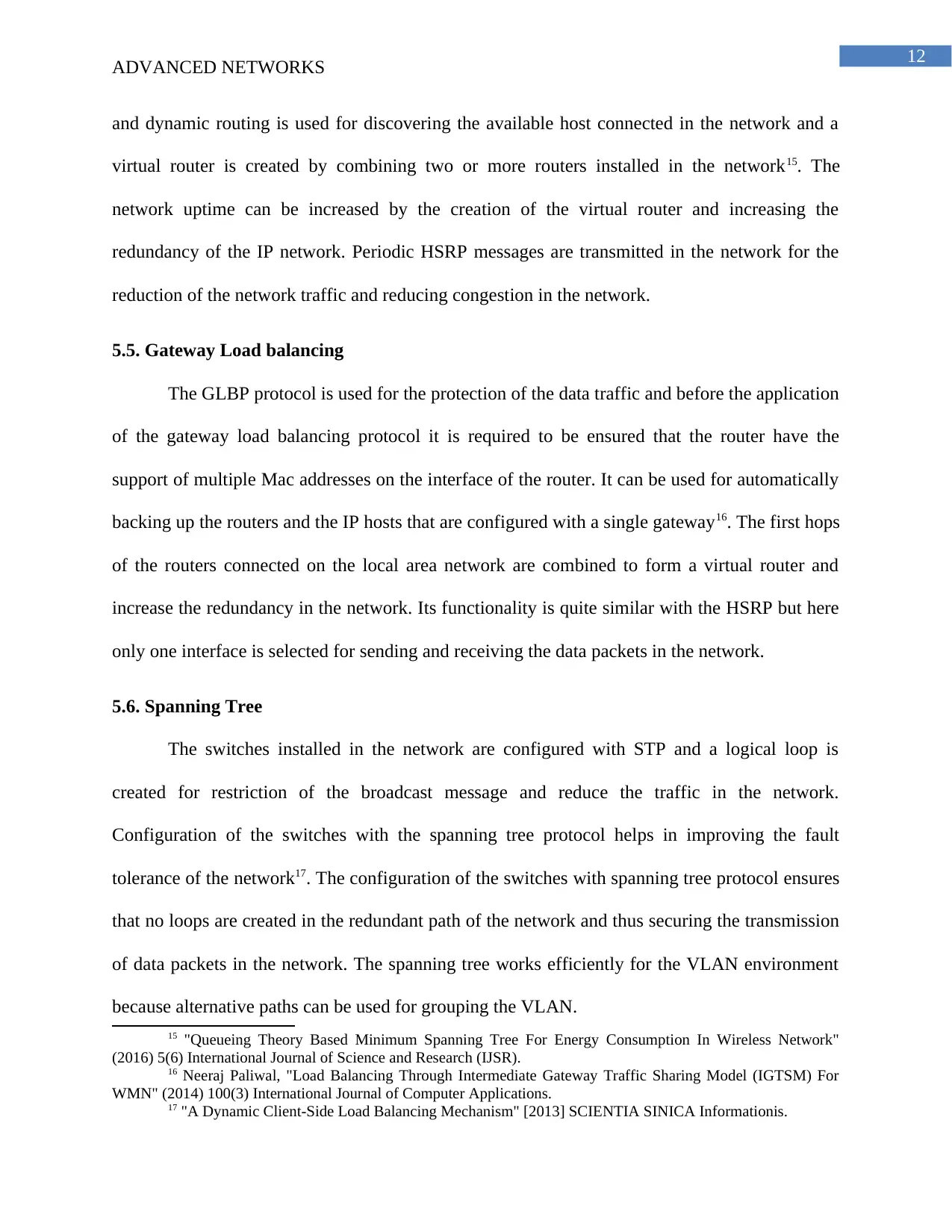
12
ADVANCED NETWORKS
and dynamic routing is used for discovering the available host connected in the network and a
virtual router is created by combining two or more routers installed in the network15. The
network uptime can be increased by the creation of the virtual router and increasing the
redundancy of the IP network. Periodic HSRP messages are transmitted in the network for the
reduction of the network traffic and reducing congestion in the network.
5.5. Gateway Load balancing
The GLBP protocol is used for the protection of the data traffic and before the application
of the gateway load balancing protocol it is required to be ensured that the router have the
support of multiple Mac addresses on the interface of the router. It can be used for automatically
backing up the routers and the IP hosts that are configured with a single gateway16. The first hops
of the routers connected on the local area network are combined to form a virtual router and
increase the redundancy in the network. Its functionality is quite similar with the HSRP but here
only one interface is selected for sending and receiving the data packets in the network.
5.6. Spanning Tree
The switches installed in the network are configured with STP and a logical loop is
created for restriction of the broadcast message and reduce the traffic in the network.
Configuration of the switches with the spanning tree protocol helps in improving the fault
tolerance of the network17. The configuration of the switches with spanning tree protocol ensures
that no loops are created in the redundant path of the network and thus securing the transmission
of data packets in the network. The spanning tree works efficiently for the VLAN environment
because alternative paths can be used for grouping the VLAN.
15 "Queueing Theory Based Minimum Spanning Tree For Energy Consumption In Wireless Network"
(2016) 5(6) International Journal of Science and Research (IJSR).
16 Neeraj Paliwal, "Load Balancing Through Intermediate Gateway Traffic Sharing Model (IGTSM) For
WMN" (2014) 100(3) International Journal of Computer Applications.
17 "A Dynamic Client-Side Load Balancing Mechanism" [2013] SCIENTIA SINICA Informationis.
ADVANCED NETWORKS
and dynamic routing is used for discovering the available host connected in the network and a
virtual router is created by combining two or more routers installed in the network15. The
network uptime can be increased by the creation of the virtual router and increasing the
redundancy of the IP network. Periodic HSRP messages are transmitted in the network for the
reduction of the network traffic and reducing congestion in the network.
5.5. Gateway Load balancing
The GLBP protocol is used for the protection of the data traffic and before the application
of the gateway load balancing protocol it is required to be ensured that the router have the
support of multiple Mac addresses on the interface of the router. It can be used for automatically
backing up the routers and the IP hosts that are configured with a single gateway16. The first hops
of the routers connected on the local area network are combined to form a virtual router and
increase the redundancy in the network. Its functionality is quite similar with the HSRP but here
only one interface is selected for sending and receiving the data packets in the network.
5.6. Spanning Tree
The switches installed in the network are configured with STP and a logical loop is
created for restriction of the broadcast message and reduce the traffic in the network.
Configuration of the switches with the spanning tree protocol helps in improving the fault
tolerance of the network17. The configuration of the switches with spanning tree protocol ensures
that no loops are created in the redundant path of the network and thus securing the transmission
of data packets in the network. The spanning tree works efficiently for the VLAN environment
because alternative paths can be used for grouping the VLAN.
15 "Queueing Theory Based Minimum Spanning Tree For Energy Consumption In Wireless Network"
(2016) 5(6) International Journal of Science and Research (IJSR).
16 Neeraj Paliwal, "Load Balancing Through Intermediate Gateway Traffic Sharing Model (IGTSM) For
WMN" (2014) 100(3) International Journal of Computer Applications.
17 "A Dynamic Client-Side Load Balancing Mechanism" [2013] SCIENTIA SINICA Informationis.
Paraphrase This Document
Need a fresh take? Get an instant paraphrase of this document with our AI Paraphraser
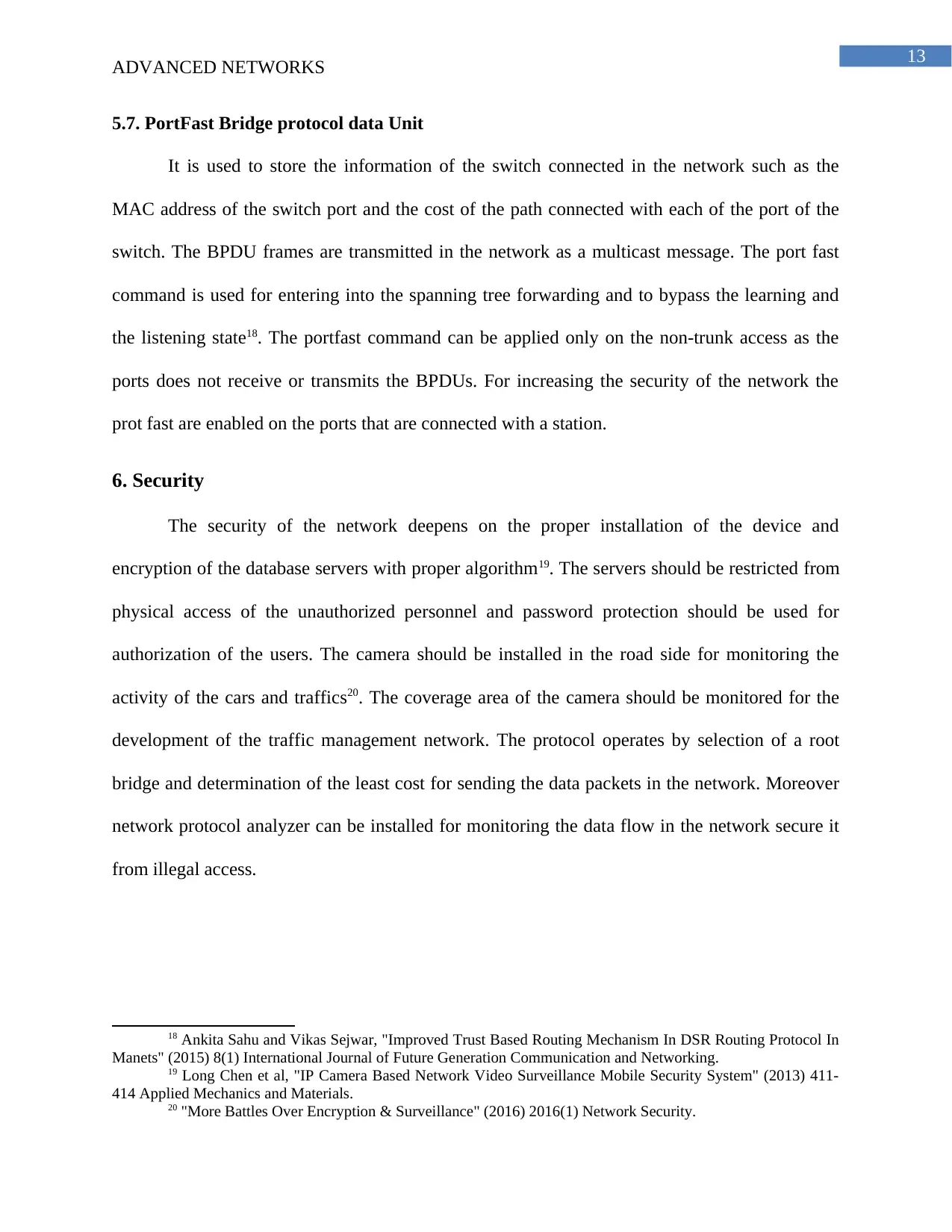
13
ADVANCED NETWORKS
5.7. PortFast Bridge protocol data Unit
It is used to store the information of the switch connected in the network such as the
MAC address of the switch port and the cost of the path connected with each of the port of the
switch. The BPDU frames are transmitted in the network as a multicast message. The port fast
command is used for entering into the spanning tree forwarding and to bypass the learning and
the listening state18. The portfast command can be applied only on the non-trunk access as the
ports does not receive or transmits the BPDUs. For increasing the security of the network the
prot fast are enabled on the ports that are connected with a station.
6. Security
The security of the network deepens on the proper installation of the device and
encryption of the database servers with proper algorithm19. The servers should be restricted from
physical access of the unauthorized personnel and password protection should be used for
authorization of the users. The camera should be installed in the road side for monitoring the
activity of the cars and traffics20. The coverage area of the camera should be monitored for the
development of the traffic management network. The protocol operates by selection of a root
bridge and determination of the least cost for sending the data packets in the network. Moreover
network protocol analyzer can be installed for monitoring the data flow in the network secure it
from illegal access.
18 Ankita Sahu and Vikas Sejwar, "Improved Trust Based Routing Mechanism In DSR Routing Protocol In
Manets" (2015) 8(1) International Journal of Future Generation Communication and Networking.
19 Long Chen et al, "IP Camera Based Network Video Surveillance Mobile Security System" (2013) 411-
414 Applied Mechanics and Materials.
20 "More Battles Over Encryption & Surveillance" (2016) 2016(1) Network Security.
ADVANCED NETWORKS
5.7. PortFast Bridge protocol data Unit
It is used to store the information of the switch connected in the network such as the
MAC address of the switch port and the cost of the path connected with each of the port of the
switch. The BPDU frames are transmitted in the network as a multicast message. The port fast
command is used for entering into the spanning tree forwarding and to bypass the learning and
the listening state18. The portfast command can be applied only on the non-trunk access as the
ports does not receive or transmits the BPDUs. For increasing the security of the network the
prot fast are enabled on the ports that are connected with a station.
6. Security
The security of the network deepens on the proper installation of the device and
encryption of the database servers with proper algorithm19. The servers should be restricted from
physical access of the unauthorized personnel and password protection should be used for
authorization of the users. The camera should be installed in the road side for monitoring the
activity of the cars and traffics20. The coverage area of the camera should be monitored for the
development of the traffic management network. The protocol operates by selection of a root
bridge and determination of the least cost for sending the data packets in the network. Moreover
network protocol analyzer can be installed for monitoring the data flow in the network secure it
from illegal access.
18 Ankita Sahu and Vikas Sejwar, "Improved Trust Based Routing Mechanism In DSR Routing Protocol In
Manets" (2015) 8(1) International Journal of Future Generation Communication and Networking.
19 Long Chen et al, "IP Camera Based Network Video Surveillance Mobile Security System" (2013) 411-
414 Applied Mechanics and Materials.
20 "More Battles Over Encryption & Surveillance" (2016) 2016(1) Network Security.
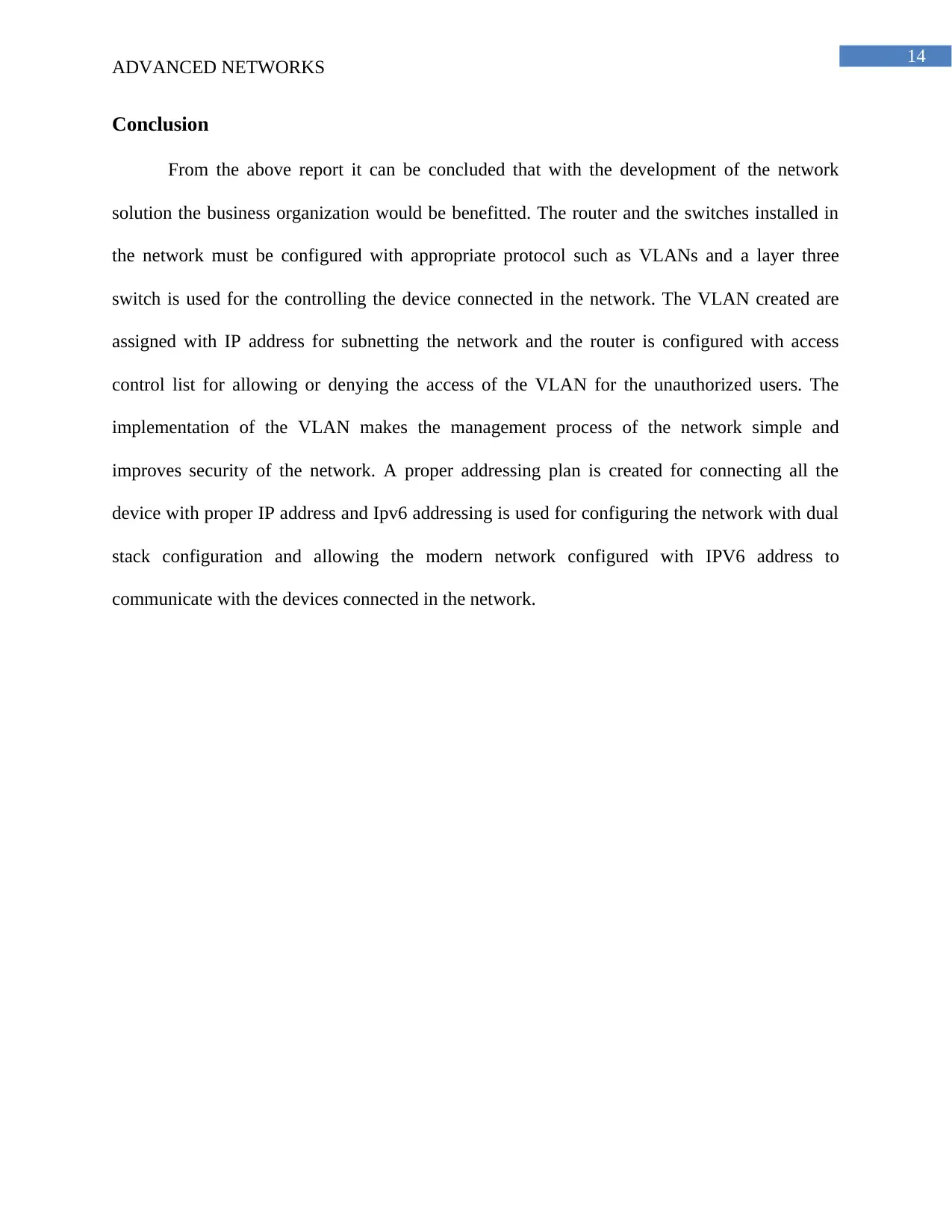
14
ADVANCED NETWORKS
Conclusion
From the above report it can be concluded that with the development of the network
solution the business organization would be benefitted. The router and the switches installed in
the network must be configured with appropriate protocol such as VLANs and a layer three
switch is used for the controlling the device connected in the network. The VLAN created are
assigned with IP address for subnetting the network and the router is configured with access
control list for allowing or denying the access of the VLAN for the unauthorized users. The
implementation of the VLAN makes the management process of the network simple and
improves security of the network. A proper addressing plan is created for connecting all the
device with proper IP address and Ipv6 addressing is used for configuring the network with dual
stack configuration and allowing the modern network configured with IPV6 address to
communicate with the devices connected in the network.
ADVANCED NETWORKS
Conclusion
From the above report it can be concluded that with the development of the network
solution the business organization would be benefitted. The router and the switches installed in
the network must be configured with appropriate protocol such as VLANs and a layer three
switch is used for the controlling the device connected in the network. The VLAN created are
assigned with IP address for subnetting the network and the router is configured with access
control list for allowing or denying the access of the VLAN for the unauthorized users. The
implementation of the VLAN makes the management process of the network simple and
improves security of the network. A proper addressing plan is created for connecting all the
device with proper IP address and Ipv6 addressing is used for configuring the network with dual
stack configuration and allowing the modern network configured with IPV6 address to
communicate with the devices connected in the network.
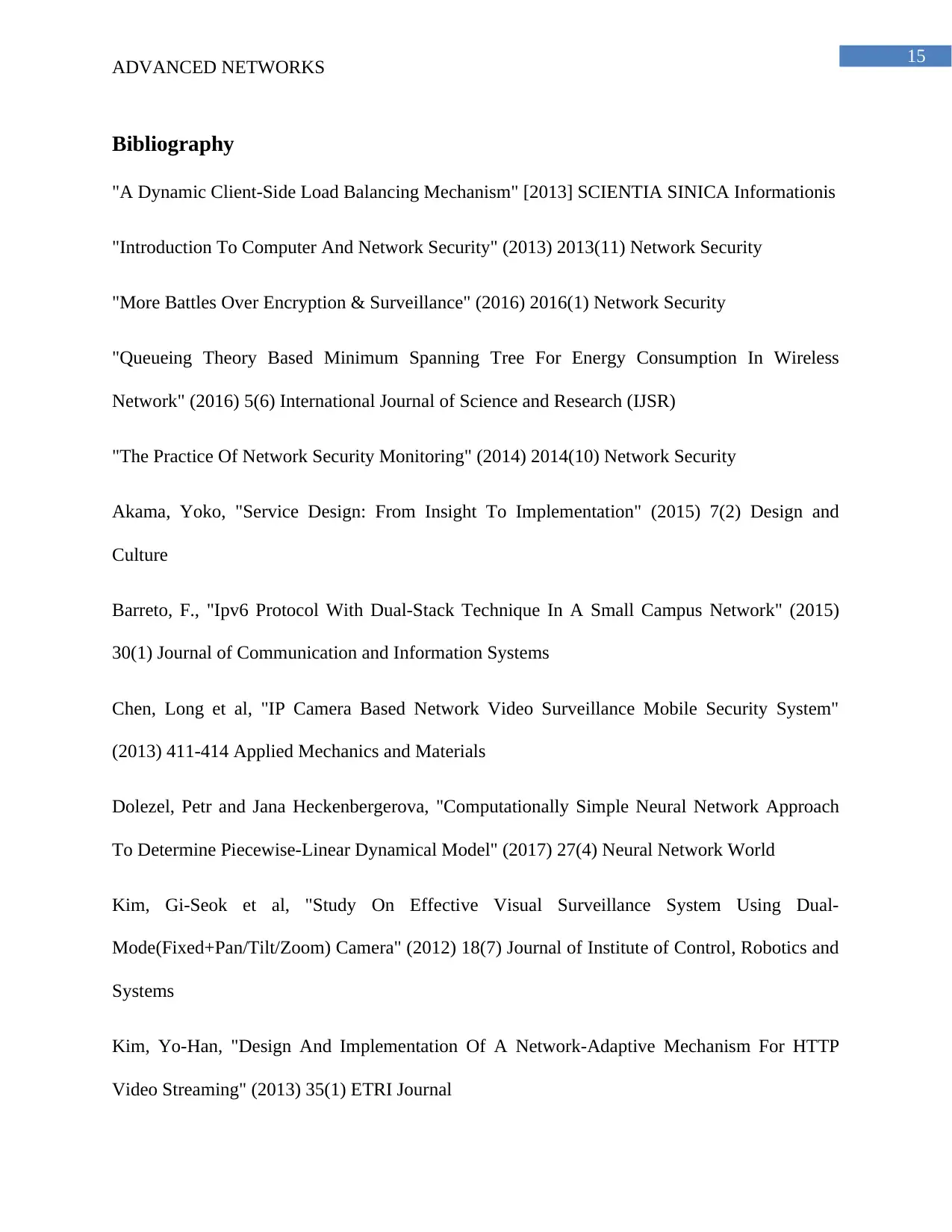
15
ADVANCED NETWORKS
Bibliography
"A Dynamic Client-Side Load Balancing Mechanism" [2013] SCIENTIA SINICA Informationis
"Introduction To Computer And Network Security" (2013) 2013(11) Network Security
"More Battles Over Encryption & Surveillance" (2016) 2016(1) Network Security
"Queueing Theory Based Minimum Spanning Tree For Energy Consumption In Wireless
Network" (2016) 5(6) International Journal of Science and Research (IJSR)
"The Practice Of Network Security Monitoring" (2014) 2014(10) Network Security
Akama, Yoko, "Service Design: From Insight To Implementation" (2015) 7(2) Design and
Culture
Barreto, F., "Ipv6 Protocol With Dual-Stack Technique In A Small Campus Network" (2015)
30(1) Journal of Communication and Information Systems
Chen, Long et al, "IP Camera Based Network Video Surveillance Mobile Security System"
(2013) 411-414 Applied Mechanics and Materials
Dolezel, Petr and Jana Heckenbergerova, "Computationally Simple Neural Network Approach
To Determine Piecewise-Linear Dynamical Model" (2017) 27(4) Neural Network World
Kim, Gi-Seok et al, "Study On Effective Visual Surveillance System Using Dual-
Mode(Fixed+Pan/Tilt/Zoom) Camera" (2012) 18(7) Journal of Institute of Control, Robotics and
Systems
Kim, Yo-Han, "Design And Implementation Of A Network-Adaptive Mechanism For HTTP
Video Streaming" (2013) 35(1) ETRI Journal
ADVANCED NETWORKS
Bibliography
"A Dynamic Client-Side Load Balancing Mechanism" [2013] SCIENTIA SINICA Informationis
"Introduction To Computer And Network Security" (2013) 2013(11) Network Security
"More Battles Over Encryption & Surveillance" (2016) 2016(1) Network Security
"Queueing Theory Based Minimum Spanning Tree For Energy Consumption In Wireless
Network" (2016) 5(6) International Journal of Science and Research (IJSR)
"The Practice Of Network Security Monitoring" (2014) 2014(10) Network Security
Akama, Yoko, "Service Design: From Insight To Implementation" (2015) 7(2) Design and
Culture
Barreto, F., "Ipv6 Protocol With Dual-Stack Technique In A Small Campus Network" (2015)
30(1) Journal of Communication and Information Systems
Chen, Long et al, "IP Camera Based Network Video Surveillance Mobile Security System"
(2013) 411-414 Applied Mechanics and Materials
Dolezel, Petr and Jana Heckenbergerova, "Computationally Simple Neural Network Approach
To Determine Piecewise-Linear Dynamical Model" (2017) 27(4) Neural Network World
Kim, Gi-Seok et al, "Study On Effective Visual Surveillance System Using Dual-
Mode(Fixed+Pan/Tilt/Zoom) Camera" (2012) 18(7) Journal of Institute of Control, Robotics and
Systems
Kim, Yo-Han, "Design And Implementation Of A Network-Adaptive Mechanism For HTTP
Video Streaming" (2013) 35(1) ETRI Journal
Secure Best Marks with AI Grader
Need help grading? Try our AI Grader for instant feedback on your assignments.
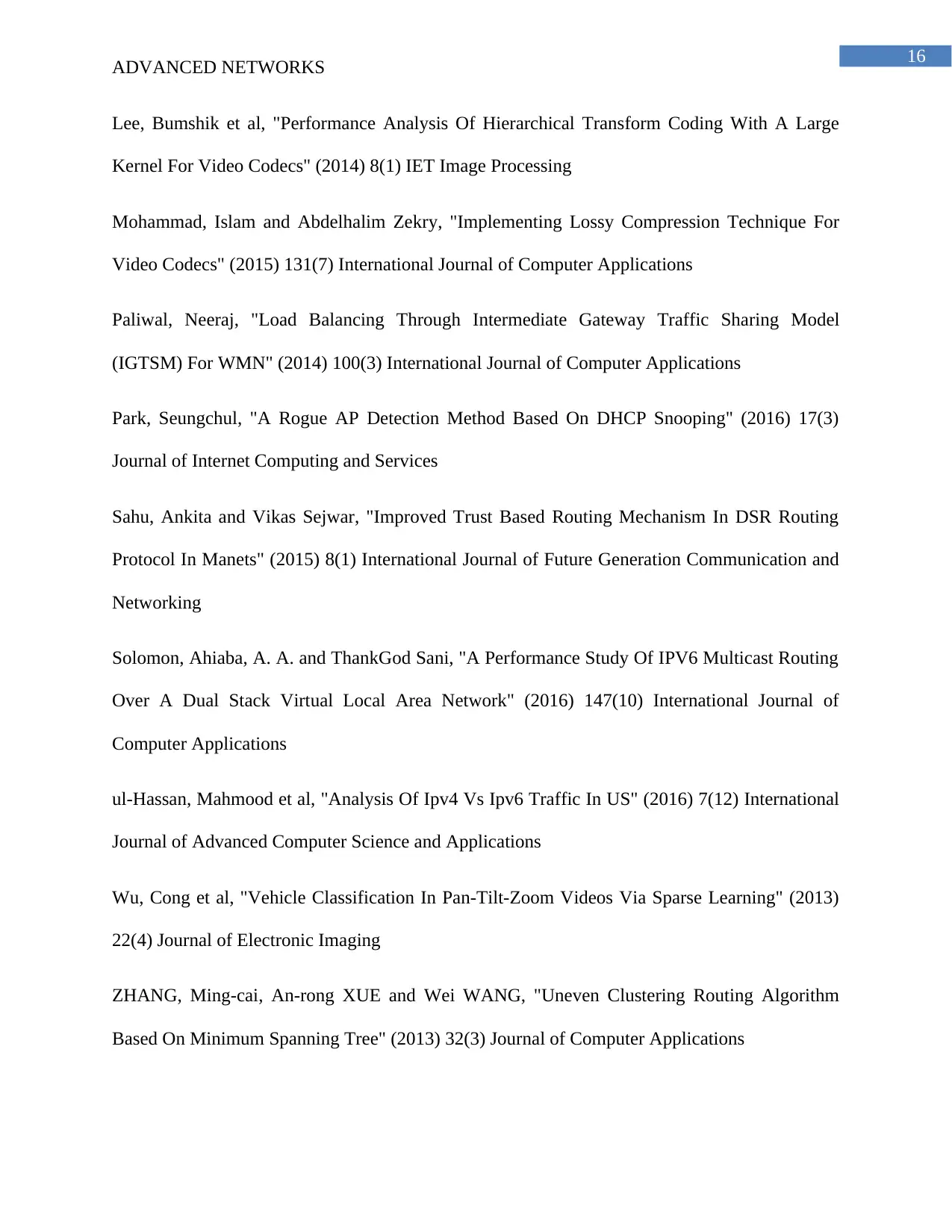
16
ADVANCED NETWORKS
Lee, Bumshik et al, "Performance Analysis Of Hierarchical Transform Coding With A Large
Kernel For Video Codecs" (2014) 8(1) IET Image Processing
Mohammad, Islam and Abdelhalim Zekry, "Implementing Lossy Compression Technique For
Video Codecs" (2015) 131(7) International Journal of Computer Applications
Paliwal, Neeraj, "Load Balancing Through Intermediate Gateway Traffic Sharing Model
(IGTSM) For WMN" (2014) 100(3) International Journal of Computer Applications
Park, Seungchul, "A Rogue AP Detection Method Based On DHCP Snooping" (2016) 17(3)
Journal of Internet Computing and Services
Sahu, Ankita and Vikas Sejwar, "Improved Trust Based Routing Mechanism In DSR Routing
Protocol In Manets" (2015) 8(1) International Journal of Future Generation Communication and
Networking
Solomon, Ahiaba, A. A. and ThankGod Sani, "A Performance Study Of IPV6 Multicast Routing
Over A Dual Stack Virtual Local Area Network" (2016) 147(10) International Journal of
Computer Applications
ul-Hassan, Mahmood et al, "Analysis Of Ipv4 Vs Ipv6 Traffic In US" (2016) 7(12) International
Journal of Advanced Computer Science and Applications
Wu, Cong et al, "Vehicle Classification In Pan-Tilt-Zoom Videos Via Sparse Learning" (2013)
22(4) Journal of Electronic Imaging
ZHANG, Ming-cai, An-rong XUE and Wei WANG, "Uneven Clustering Routing Algorithm
Based On Minimum Spanning Tree" (2013) 32(3) Journal of Computer Applications
ADVANCED NETWORKS
Lee, Bumshik et al, "Performance Analysis Of Hierarchical Transform Coding With A Large
Kernel For Video Codecs" (2014) 8(1) IET Image Processing
Mohammad, Islam and Abdelhalim Zekry, "Implementing Lossy Compression Technique For
Video Codecs" (2015) 131(7) International Journal of Computer Applications
Paliwal, Neeraj, "Load Balancing Through Intermediate Gateway Traffic Sharing Model
(IGTSM) For WMN" (2014) 100(3) International Journal of Computer Applications
Park, Seungchul, "A Rogue AP Detection Method Based On DHCP Snooping" (2016) 17(3)
Journal of Internet Computing and Services
Sahu, Ankita and Vikas Sejwar, "Improved Trust Based Routing Mechanism In DSR Routing
Protocol In Manets" (2015) 8(1) International Journal of Future Generation Communication and
Networking
Solomon, Ahiaba, A. A. and ThankGod Sani, "A Performance Study Of IPV6 Multicast Routing
Over A Dual Stack Virtual Local Area Network" (2016) 147(10) International Journal of
Computer Applications
ul-Hassan, Mahmood et al, "Analysis Of Ipv4 Vs Ipv6 Traffic In US" (2016) 7(12) International
Journal of Advanced Computer Science and Applications
Wu, Cong et al, "Vehicle Classification In Pan-Tilt-Zoom Videos Via Sparse Learning" (2013)
22(4) Journal of Electronic Imaging
ZHANG, Ming-cai, An-rong XUE and Wei WANG, "Uneven Clustering Routing Algorithm
Based On Minimum Spanning Tree" (2013) 32(3) Journal of Computer Applications

17
ADVANCED NETWORKS
Zhao, Hong, Chun-long Zhou and Bao-zhao Jin, "Design And Implementation Of Streaming
Media Server Cluster Based On Ffmpeg" (2015) 2015 The Scientific World Journal
ADVANCED NETWORKS
Zhao, Hong, Chun-long Zhou and Bao-zhao Jin, "Design And Implementation Of Streaming
Media Server Cluster Based On Ffmpeg" (2015) 2015 The Scientific World Journal
1 out of 18
Related Documents
Your All-in-One AI-Powered Toolkit for Academic Success.
+13062052269
info@desklib.com
Available 24*7 on WhatsApp / Email
![[object Object]](/_next/static/media/star-bottom.7253800d.svg)
Unlock your academic potential
© 2024 | Zucol Services PVT LTD | All rights reserved.





